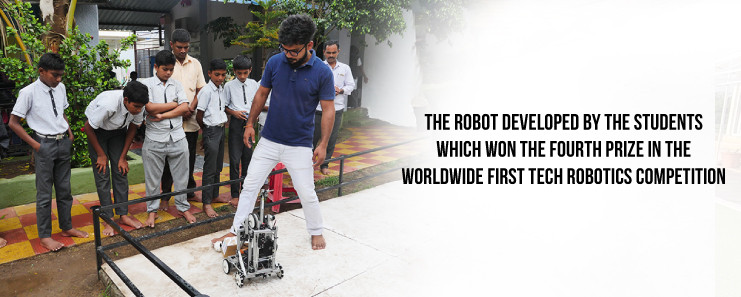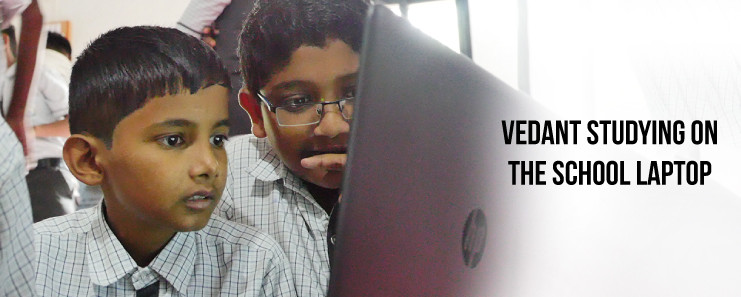Like a devout pilgrim, Vedant bows down and touches the steps of his school as soon as he reaches at 7.30 am sharp. Located in the village of Wablewadi, Pune, Ojas International School is setting an example for the education sector. At 8 am, Vedant, along with his schoolmates, begins cleaning the premises of 13 classrooms with brooms and mopping sticks. After that, the 11-year-old spends his time learning and inventing in the robotics room of the school till 8 pm, three hours past the official school timing.
Siddhi, another student from the same school has created a model that cuts water usage by 90%. Impressed, the school headmaster implemented her model in the school.
The school is currently teaching over 600 students. Despite its label of being a government school, it is training its students in the skills of the future: flying drones, creating 2-D and 3-D animation, coding, photography, robotics, sound engineering, farming, along with sports, music, and languages. Based on their interest, the students pursue one of these skills or modules, as they are called. And students are not just excelling in their chosen skills. They are also acing state board exams. In the recent 2019 exams, 47 students from the school secured state merit scholarship.
“Compared to the West, our country lacks inventions. I want to contribute to my country with new inventions,” says Vedant. Till now, he has made a vacuum machine, an LED bulb, a voting machine, and a smart dustbin which opens whenever an object comes near it. He, along with his classmates, is now working on making a model of a wifi car. Recently, he was part of the school team that won the fourth prize in the worldwide First Tech Challenge Robotics Competition.

A brainchild of the school headmaster, Dattatray Ware, the school’s curriculum is equipping children to solve everyday problems and problems of the future. “We don’t provide these kids with readymade solutions. So, they solve problems on their own. They have made models on their own, using digital platforms like Youtube,” says Dattatray, who further adds that the sole inspiration behind such a dynamic curriculum is children.
“Over the years, as a teacher, I observed that conventional learning blocks a child’s creativity. I wanted to see children pursue their interests.”
“Then I thought that we must give children a chance to learn things which the future demands. That is when the idea of Project Avishkar, the skill-based curriculum offering ten modules, was born,” he adds.

Inspiring communities and experts
Dattatray’s love for his students and his revolutionary idea eventually attracted children from all over the district. From 32 students in 2012, the school grew to 650 students in a span of seven years. And that is not it. There is also a list of 3,500 students waiting to be enrolled in this school. The students come from 25 nearby villages and are mostly children of small-scale farmers.
Struck with the growth of their children, many parents voluntarily help with the needs of the school. Sachin Wable, a parent remarks, “The school has improved my son’s personality. He has become more intelligent. We have a deep connection with the school. That is why all villagers contribute something to it. Even though I have health issues, I voluntarily help in the administrative work of the school.”
Like Sachin, many parents contribute to the school’s development. Some parents have helped to construct new classrooms. Others have donated land. As a result, the school that started between small walls of 0.125 acres has now spread across more than three acres.
The school is also India’s first zero-energy school where 8 classrooms are zero-energy classrooms and the rest are powered by solar energy. “This area has frequent electricity problems. Solar energy has helped us to carry on with our special curriculum,” says Dattatray.

IAHV (International Association of Human Values), a sister concern of The Art of Living in association with Bank of New York Mellon has funded the eco-friendly classrooms of the school and the rest of the infrastructure required to run its skill-based curriculum.
No wonder, to Dattatray, the school is more like a blessing from Gurudev Sri Sri Ravi Shankar. As he says, “The school is not just a school. It is a blessing from the Master for the bright future of the young minds of the village.”
When asked about his future goals, Dattatray shares, “I wish this model of education is replicated all across government schools in India. That is why I arrange visits of education experts from India and across the globe.” Upon his visit, Vijay Bhatkal, a renowned scientist called this school his dream school.
We certainly hope Dattatray’s dream comes true and the revolutionary education model empowers students across India.
Story source: The Art of Living Bureau of Communication
Written by: Vanditaa Kothari
We’d love to hear from you.
Leave your comments @artofliving
Interact with the author @vanditaa1





